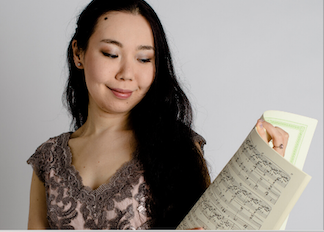CD Review: “Romantic Fantasies”
Aliya Turetayeva, piano
KNS Classical
Kazakhstan-born Aliya Turetayeva’s new album is devoted to two major solo piano works by Schumann: the Piano Sonata No. 2 in G minor, Op. 22, and the large set of “fantasies in the style of Callot” (Schumann’s original subtitle) called Kreisleriana, inspired by E.T.A. Hoffmann. The two works enjoy certain similarities, including G minor/B-flat major polarity, constant rhythmic displacement, and white-hot restlessness. Strictly speaking, of course, the sonata is not a fantasy, but I’d like to think the pianist is hearkening to the German word Phantasie (imagination), with which Schumann was abundantly blessed.
In the first movement of the sonata, Ms. Turetayeva plays with uncommon musicality and detailed phrasing, however, the movement is marked so rasch wie möglich (as fast as possible, a typical hyperbolic indication by Schumann), and Ms. Turetayeva never sounds quite breathless enough, or “on the absolute limit” of what is achievable. She often breathes deeply between phrases, normally an admirable quality, but one which interrupts the collective rush. I’d like to hear the same thoughtfulness kicked up two notches.
The second movement, Andantino, is a reworking of one of Schumann’s early songs: Im Herbste (In Autumn, poem by Kerner), and here Ms. Turetayeva’s pianism is gorgeously still and full of quiet longing: “Be silent, you little birds,/So that I, I alone,/May sing and blossom for her.” Both the Scherzo and the concluding Rondo: Presto share the same lack of extremity that I noted in the first movement. Clearly, Ms. Turetayeva is a wonderful lyrical player, and it is a pleasure to hear a young pianist who considers every note and phrase deeply, but when in Schumann’s world, one has to partake of the disturbed quality or it all winds up sounding a bit cautious—a little more Florestan to balance the Eusebius.
Ms. Turetayeva fares much better in the eight pieces of Kreisleriana, a diary of pathological sensitivity, where she begins with exactly that passionate surge I wished for earlier. Her imagination is quite original, and she takes the middle section of the first piece a lot slower than the two outer sections, which is a valid choice, however, I’d suggest she explore keeping the same tempo to see if anything occurs to her.
In the second piece, Ms. Turetayeva hesitates before every downbeat in the theme that recurs so often. If it were done once, it could be very effective. She plays the longer second edition (overseen by Clara Schumann and Brahms), which some scholars say should be retired, for it makes nearly everything symmetrical, adding repeats where Schumann didn’t want them and occasionally removing them where he did. Clara, ever the performer, pleaded with the composer to write something “a bit more comprehensible” for her audiences, saying that these pieces “frightened” her. Although Schumann claimed to have composed the set in four days, it underwent a very long period of revision (at least five years).
The fourth piece is another highlight, leading directly into a wonderfully light and spirited rendition of the fifth. I suspected that Ms. Turetayeva’s rendition of the sixth piece would be wonderful, and it did not disappoint, with its fragmented reference to the Grossvatertanz (concluding piece played at every ball, also found in Papillons and Carnaval). There was plenty of fire in the seventh piece, though she did render some portato indications as outright staccati. The final piece was beautifully played, but I prefer a bit more of the “death on a pale horse” quality- Erlking galloping away with his victim. Ms. Turetayeva has a habit of repeating the exact rubato on every recurrence of a phrase, and the downbeat hesitation again interferes with ideal accumulation of panicked momentum.
For those who like their Schumann ultra-contemplative, this is the recording for you. The program notes are very heartfelt, though they could have used closer inspection by someone fluent in English, and the recorded sound is a bit “close” for my taste, but it enables one to hear Ms. Turetayeva’s detailed account of this complex music. Congratulations to Ms. Turetayeva, I’m sure she will go far in her career.

